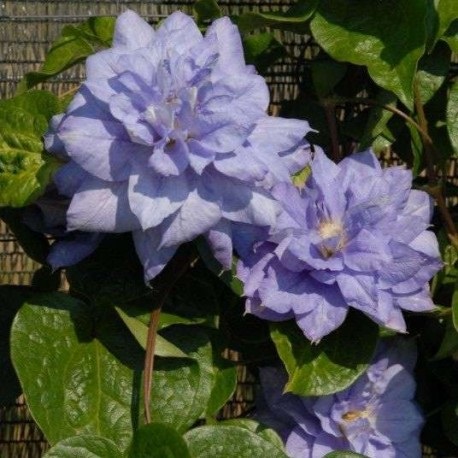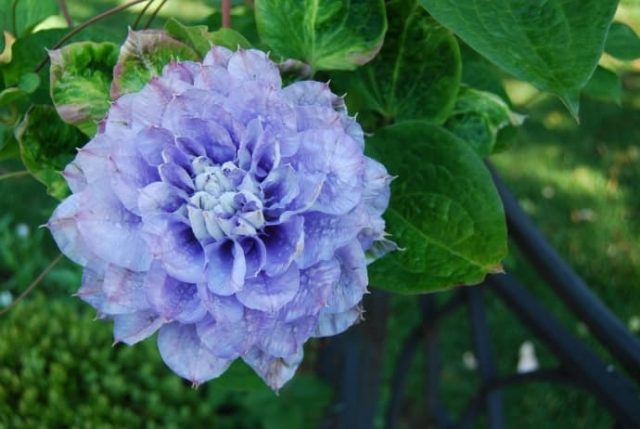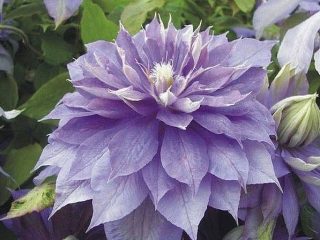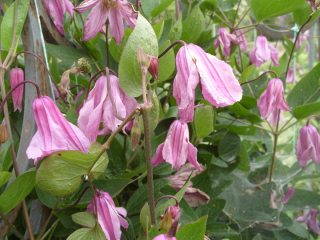Content
Lianas are becoming more and more widespread in the landscaping of homestead and summer cottages in Russia, including clematis Mazuri. To understand all the benefits of the plant, you need to get to know the Mazury variety better.
Description of clematis Mazuri
Large-flowered clematis Mazury bred by Polish breeders. The variety is quite young, but, nevertheless, received a silver medal at the exhibition "Green is life" in 2006 in Warsaw. The Mazury variety has the following characteristics:
- Bright double flowers of blue or lilac color, with a diameter of 13 - 17 cm. On the petals there are small spots of a lighter color, which makes them fragile and airy.
- The liana reaches a height of 2 - 3 meters, while, as the culture grows, it clings to the supports with leaf petioles.
- The plant blooms from July to September.
- Likes well-lit, sunny places, can grow in partial shade. Poorly tolerated by the wind.
- The culture is doing well in the European part of the Russian Federation and in the south of the Far East.
- Refers to the third group of trimming.
Clematis pruning group Mazuri
Producers classify Mazury as a third type of pruning, which blooms on new shoots in summer and early fall. In winter, all the stems of the previous year die.
The Mazury variety should produce mature stems every season. To do this, select 2 - 3 living kidneys at a height of no more than 30 - 50 cm and remove everything else. This allows clematis to grow new strong shoots and give flowering.
In the first year of life, vines are made special pruning. Each cultivar, regardless of the group, should be pruned about 10 cm from the ground in late winter or early spring. This is done in order for clematis to acquire the habit of denser growth, with flowers at the base of the plant. The procedure may not be performed: then the flowering will not be dense, and the flowers will be located high from the ground. There is no need to worry about leaving the buds: clematis sprouts underground sprouts from the nodes.
Pruning should be carried out, regardless of the climatic zone in which the Mazury variety is grown, and even if last year's branches were not frozen in winter. This allows the liana to bloom more luxuriantly. Otherwise, old stems will have poor flowering, and new shoots will not gain strength for this.
Planting and caring for clematis Mazuri
Large-flowered clematis (marque) Mazury is widely represented on the market. A marque indicates that the root system was in a moist substrate and the plant was kept refrigerated. Here are some helpful tips for choosing clematis varieties.
Before planting the Mazury variety, you need to choose a place where the plant will feel best and will reveal its full potential. The site must meet the following requirements:
- Good light: although Mazury can grow in partial shade, it will thrive best in the sun.
- Windproof. When planting clematis, you must take into account the wind rose on the site.
- Moderate humidity. It is not recommended to plant the Mazury variety near houses along the line of water flow from the roof and next to metal fences from a profile sheet. You can not place the plant in lowlands flooded with water during rains or melting snow.
In central Russia, the Mazuri variety is planted only in the spring, and in the southern regions this can be done in the fall.
Landing should be done as follows:
- Dig a hole 50x50x50 cm in size. The root system of clematis is superficial, so 50 cm depth will be enough for the plant.
- Lay a drainage layer on the bottom to avoid root rot.
- If the soil is clayey, the pit should be filled with humus: best of all with horse or cow (1 part), with the addition of river sand (2 parts).
- The plant must be planted in a cone formed in the center of the hole.
- Spread the roots of the vine.
- If the stalk, prepared for planting, has a lignified trunk, then the neck of the bush, where the buds are located, must be buried 10 cm into the ground.
- If new shoots have already begun to grow, then planting should be carried out in such a way that at the end of summer the whip can be covered with a layer of earth of 10 cm.
- Clematis Mazury is spilled and made sure that the soil does not dry out.
- The ground around the plant is mulched by 15 - 25 cm.
All care in the first year of planting for clematis of the Mazury variety will consist in timely watering and making sure that the stems of the plant stretch along the supports.
Preparing for winter:
- a bucket of humus is poured onto the roots of clematis Mazuri;
- remove the vine from the supports and lay it on the formed hill;
- take measures to prevent the kidneys from gnawing mice: cover them with spruce branches, or a rag dipped in vinegar or tar;
- the top is covered with a layer of non-woven material.
Spring activities:
- when the snow melts, the vines are pruned according to the third type;
- level humus poured in the fall;
- Clematis Mazury should be covered with non-woven material from the aggressive spring sun and possible frost;
- during the growing season, when the buds begin to grow, the plant is watered 2 times with nitrogen fertilizer;
- in the future, top dressing of clematis is carried out with an emphasis on phosphorus and potassium.
The size of the vine's root system greatly affects the survival, growth of the bush and the abundance of flowering.
The video will help you learn more about how to get the plant to bloom magnificently:
Reproduction
To preserve the purity of the Clematis Mazury variety, they are not propagated by seeds. Breeding methods:
- By cuttings.
- Leaving the vine.
- By dividing the bush.
All methods are applied in the spring and summer so that clematis takes root well.
Cuttings of clematis Mazury
To obtain high-quality planting material of the Mazury variety, the middle part of the shoot is selected to the place where flower buds begin to wake up. Each stalk should only have one pair of leaves.
Training:
- a knife or pruner is sharpened and disinfected;
- in order to cut the cuttings, take the middle part of the shoots;
- if working with two pairs of leaves, then the lower one should be removed;
- below, at a distance of 6 - 8 cm from internodes, an oblique cut is made - to increase the area and improve root formation;
- prepared cuttings are placed from 3 to 5 hours in a solution of sodium guamate (6 g per liter of water) or for 16 hours in a solution of Zircon, Epin, Kornevin or Heteroauxin (100 ml per liter of water).
The place for landing is chosen in partial shade, or where the sun is early in the morning and after 17:00 hours. The soil should be loose, nutritious and breathable. Clematis roots grow not only from internodes, but also from stems. The cuttings are immersed in the ground at a slight angle, to the very leaves.
A plastic bottle with a cut bottom or a transparent container is installed on top, thus forming a kind of mini-greenhouses that will help the clematis cuttings to take root.
To prevent the root system from being damaged during transplanting, it is recommended to plant the cuttings in shipping pots or plastic cups.
You can find out more about when and how to carry out cuttings of clematis from the video:
Removal of the vines of clematis Mazuri
An easier way to propagate clematis Mazury is to remove the vine
Description of the method.
At a distance of 15 - 20 cm from the bush, a small ditch is dug and filled with humus.As the shoot grows, the lianas are laid on the prepared soil and pinned well to it. Many gardeners prefer this particular breeding method for clematis.
Roots begin to grow from internodes downward, and new shoots upward. As the stem lignifies, it is sprinkled with humus. This method is used when it is necessary to close a wall or a gazebo, and there is not enough planting material.
If you need to transplant clematis to another place, then in the spring the branch is separated along with a lump of earth and planted in a prepared hole.
Dividing the clematis bush Mazuri
Gardeners do not practice the propagation of the Mazury variety by dividing the bush, since the mother plant is injured. This leads to diseases of clematis and poor flowering.
The division of the bush is carried out as follows:
- Dig up the whole plant, trying to damage the root system as little as possible.
- The rhizome is washed in water.
- Untangling the roots with your hands, divide the vine into several parts.
- The umbilical cords connecting the individual processes to each other are cut with pruning shears or scissors.
Diseases and pests of the Mazury variety
Correct farming techniques of clematis Mazuri will prevent the defeat of the vine by various ailments. Lianas rarely get sick with viral diseases, but fungal diseases are not excluded.
The most common ones are:
- gray rot;
- fusarium;
- brown spotting;
- rust;
- powdery mildew;
- wilting - wilt.
Withering is the most dangerous for the plant. If a defeat occurs, then the entire bush must be dug up and destroyed. The place where the Mazuri liana grew is also better to carefully process with copper sulfate and Fundazol.
Of the pests for clematis, the Mazury variety is dangerous:
- aphid;
- spider mite;
- slugs;
- snails;
- caterpillars;
- bear;
- mouse.
To combat, you can use an infusion of soap or standard insecticides.
Conclusion
Clematis Mazuri produces large, sky-transparent flowers that can decorate any area. You can decorate gazebos and buildings with flowering lashes of a plant, create openwork arches, while shading the space from the sun.










